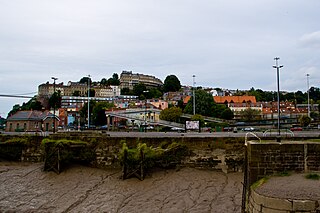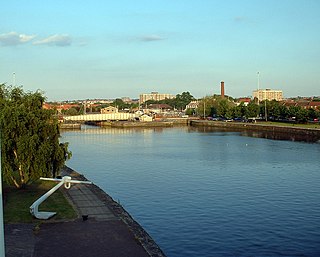A hydraulic accumulator is a pressure storage reservoir in which an incompressible hydraulic fluid is held under pressure that is applied by an external source of mechanical energy. The external source can be an engine, a spring, a raised weight, or a compressed gas. An accumulator enables a hydraulic system to cope with extremes of demand using a less powerful pump, to respond more quickly to a temporary demand, and to smooth out pulsations. It is a type of energy storage device.
The London Hydraulic Power Company was established in 1883 to install a hydraulic power network in London. This expanded to cover most of central London at its peak, before being replaced by electricity, with the final pump house closing in 1977.

Bristol Harbour is the harbour in the city of Bristol, England. The harbour covers an area of 70 acres. It is the former natural tidal river Avon through the city but was made into its current form in 1809 when the tide was prevented from going out permanently. A tidal by-pass was dug for 2 miles through the fields of Bedminster for the river, known as the "River Avon New Cut", "New Cut", or simply "The Cut". It is often called the Floating Harbour as the water level remains constant and it is not affected by the state of the tide on the river in the Avon Gorge, The New Cut or the natural river southeast of Temple Meads to its source.

Grimsby Dock Tower is a hydraulic accumulator tower and a maritime landmark at the entrance to the Royal Dock, Grimsby, in North East Lincolnshire, England. It was completed on 27 March 1852, based on William Armstrong's idea of the hydraulic accumulator, with the purpose of containing a 30,000-imperial-gallon (140,000 L) reservoir at a height of 200 feet (61 m), that was used to provide hydraulic power to power the machinery of the Grimsby Docks. The extreme height of the tower was necessary to achieve sufficient pressure, and as a result of this, the tower can be seen for several miles around, even far inland on the north bank of the Humber estuary in villages such as Patrington.

Cabot was a council ward that covered the centre of Bristol, England. It took its name from the Cabot Tower, a memorial tower on Brandon Hill that was built to commemorate John Cabot's voyage and "discovery" of North America. The ward was abolished in 2016.

A hydraulic power network is a system of interconnected pipes carrying pressurized liquid used to transmit mechanical power from a power source, like a pump, to hydraulic equipment like lifts or motors. The system is analogous to an electrical grid transmitting power from a generating station to end-users. Only a few hydraulic power transmission networks are still in use; modern hydraulic equipment has a pump built into the machine. In the late 19th century, a hydraulic network might have been used in a factory, with a central steam engine or water turbine driving a pump and a system of high-pressure pipes transmitting power to various machines.

Hotwells is a district of the English port city of Bristol. It is located to the south of and below the high ground of Clifton, and directly to the north of the Floating Harbour. The southern entrance to the Avon Gorge, which connects the docks to the sea, lies at the western end of Hotwells. The eastern end of the area is at the roundabout where Jacobs Well Road meets Hotwell Road. Hotwells is split between the city wards of Clifton, and Hotwells and Harbourside.

The Hydraulic engine house is part of the "Underfall Yard" in Bristol Harbour in Bristol, England.

The Cumberland Basin is the main entrance to the docks of the city of Bristol, England. It separates the areas of Hotwells from the tip of Spike Island.

The Nova Scotia is a historic nineteenth century pub on Spike Island adjacent to the Cumberland Basin in Bristol Harbour in Bristol, England. It was originally built as a terrace of three houses and then converted into a pub. It is a grade II listed building. It was a coaching inn and traces of large lanterns and the entrance to the coach yard survive.

The Underfall Yard is a historic boatyard on Spike Island serving Bristol Harbour in England.

St Andrews Uniting Church is a heritage-listed church at 131 Creek Street, Brisbane CBD, City of Brisbane, Queensland, Australia. It was designed by George David Payne and built in 1905 by Alexander Lind & Son. Initially St Andrews Presbyterian Church, it became part of the Uniting Church following the merger of the Presbyterian, Methodist and Congregational Churches in 1977. It was added to the Queensland Heritage Register on 21 October 1992.

Moor Park Methodist Church is a former Methodist church in Garstang Road, Preston, Lancashire, England. It is recorded in the National Heritage List for England as a designated Grade X listed building.

Prince Street Bridge is a swing bridge across Bristol Harbour. It is now Grade II listed. The bridge carries a road from Prince Street to Wapping Road and is located between the Arnolfini art centre and M Shed museum.

Carrington Pump House is a heritage-listed former hydraulic power station at 106 Bourke Street, Carrington, City of Newcastle, New South Wales, Australia. It was built from 1877 to 1878 by William H. Jennings. It is also known as Hydraulic Engine House and Crane Bases Nos. 7, 8, 9 and 10 and Carrington Hydraulic Power Station. It was added to the New South Wales State Heritage Register on 25 August 2017.

The Hydraulic Pump Station is a heritage-listed former hydraulic power station and now bar at 17 Little Pier Street, Haymarket, City of Sydney, New South Wales, Australia. It was built from 1889 to 1891. It was added to the New South Wales State Heritage Register on 2 April 1999.

British industrial architecture has been created, mainly from 1700 onwards, to house industries of many kinds in Britain, home of the Industrial Revolution in this period. Both the new industrial technologies and industrial architecture soon spread worldwide. As such, the architecture of surviving industrial buildings records part of the history of the modern world.


















